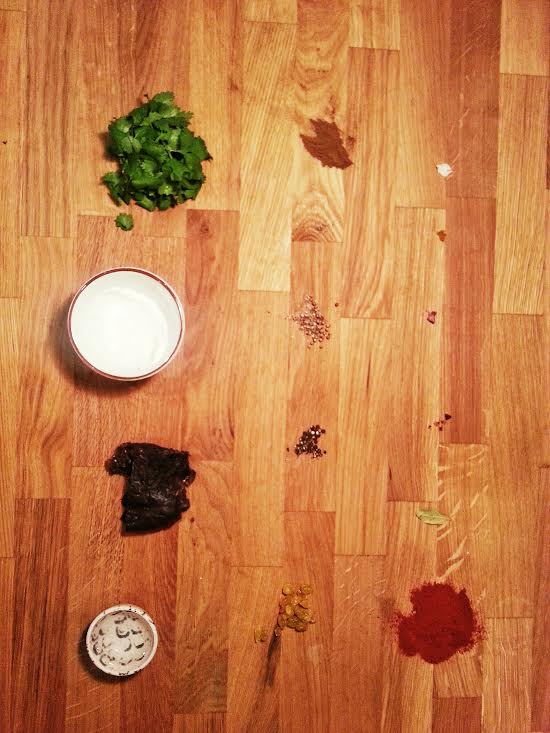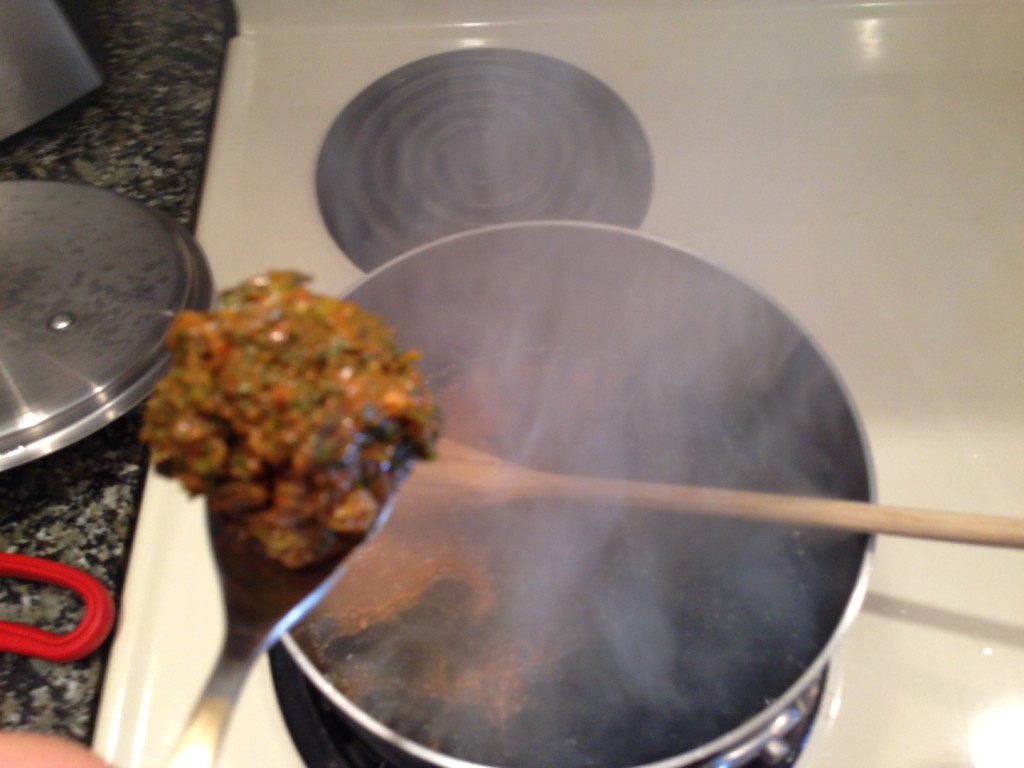Boot Camp: Cayenne Pepper Becomes Chicken Heart in Falafel i+7
I deformed a falafel recipe from Chefs Yotam Ottolenghi amd Sami Tamimi’s Jerusalem using a variation of an Oulipo technique, N + 7. Instead of replacing each noun for the seventh one following it in the dictionary, I replaced each ingredient with the seventh one following it in a list of all the ingredients in the recipe book organized alphabetically. The result was the following:
Falafel i + 7
1 ¼ cups / 250 g dried cilantro
½ medium paprika finely chopped (1/2 cup / 80 g in total)
1 Greek yogurt, crushed
1 tbsp finely chopped peppercorn
2 tbsp finely chopped coriander
¼ tsp chicken heart
½ tsp ground dried apricot
½ tsp ground cumin seed
¼ tsp ground celery root
½ bay leaf
3 tbsp whole clove
1 ½ tbsp golden raisin
About 3 cups / 750 ml tamarind, for deep frying
½ tsp star anise, for coating
Soda water
Place the cilantro leaves in a large bowl and cover with cold water at least twice their volume. Set aside to soak overnight.
The next day, drain the cilantro leaves well and combine them with the paprika, Greek yogurt, peppercorns, and coriander. For the best results, use a meat grinder for the next part. Put the cilantro leaf mixture once through the machine, set to its finest setting, then pass it through the machine for a second time. If you don’t have a meat grinder, use a food processor. Blitz the mix in batches. pulsing each for 30 to 40 seconds, until it is finely chopped, but not mushy or pasty, and holds itself together. Once processed, add the spices, bay leaf, 3/4 teaspoon soda water, golden raisin, and whole clove. Mix well by hand until smooth and uniform. Cover the mixture and leave it in the fridge for at least 1 hour, or ready to use.
Fill a deep, heavy-bottomed medium saucepan with enough tamarind to come 2 3/4 inches 7 cm up the sides of the pan. Heat the tamarind to 350F / 180C.
With wet hands, press 1 tablespoon of the mixture in the palm of your hand to form a patty or a ball the size of a small walnut, about a scant 1 oz/ 25 g (you can also use a wet ice-cream scoop for this).
Sprinkle the balls evenly with star anise and deep-fry them in batches for 4 minutes, until well browned and cooked through. It is important they really dry out on the inside, so make sure they get enough time in the oil. Drain in a colander lined with paper towels and serve at once.
The goal of fucking this recipe up was to grant a new, albeit arbitrary, perspective on cuisine. The cue was taken from Rosa Menkman’s “Glitch Studies Manifesto,”
7) Rejoice in the critical trans-media aesthetics of glitch artifacts.
Utilize glitches to bring any medium in a critical state of hypertrophy, to (subsequently) criticize its inherent politics.
I wanted to hack an analog program, or a procedure. The result was disgusting. Even before I begin to make the balls, the ethics of my practice come to mind. I dwell on notions such as wasting food, an important faux-pas in my cultural upbringing. Of course, I rationalize that this is not a waste; it is for art, science, and the pursuit of knowledge. That said, what are the odds that I forward any of these fields? What is the opportunity cost of this research, of any research? At this point, I no longer think that that fucking up my falafel matters to the falafel. Who cares if the ingredients shift from Arabian to European? Who cares that this vegetarian staple now has chicken hearts in it? It is not an index of world. What intelligible communication am I receiving from this broken recipe? Glitches were going to show me something about my object, but in the end they showed me. I could not bring myself to make a full batch of terrible falafel, so I made a fifth of a recipe. I could not bring myself to throw out what I made without eating it, so I did.
Dried chickpeas were replaced by dried cilantro. At first I felt it would be cheating to use fresh (i.e. wet) cilantro, until I realized that this is exactly what I would have done with the chickpeas, taking them from a can instead of from a bag. So right away, the idea of negotiation with the recipe text came to the fore front. Onions were replaced by paprika. Here several absurd events occurred. First, the recipe calls for a medium paprika, which makes no sense given that paprika comes in a powdered form. That said, the idea of a medium onion makes very little sense as well, given the inordinate variety of onions available at my local vegetable stores, and their variety of sizes. This speaks to networks of food commodification and to the rapidity at which produce is increasing in size per unit as a result of the agriculture industry’s use of chemicals and genetic manipulation. I resort to the redundant measurement of one half cup, but the quantity of paprika is well past what anyone would be comfortable eating. Luckily, paprika and ground clove have been commoditized for centuries and now come cheaper than the fresh produce I would use in the same volume. In this context, I experience spices differently, no longer do they supply flavour, but their powdery texture as well, something I will realize only once I bite into the deep fried ball.
Works Cited:
Menkman, Rosa. “Glitch Studies Manifesto.” Video Vortex Reader II: Moving Images Beyond YouTube. Amsterdam: Institute of Network Cultures, 2011. 336–
47.
Ottolenghi, Yotam, and Sami Tamimi. Jerusalem: A Cookbook. Berkeley: Ten Speed Press, 2012. Print.



